Circular seating arrangement questions for bank PO prelims exams are available here. In the reasoning ability section, seating arrangement is an important topic. There are various types of seating arrangement questions. Among them, circular seating arrangement questions are very common in bank exams. In the SBI PO & IBPS PO prelims exams, you can expect one set of Circular seating arrangement, covering around 5 marks. So, practice well on all the Circular seating arrangement questions for bank PO prelims exams given here. On practice, you can attain speed and accuracy. Hence, utilize this Circular seating arrangement questions with answers pdf in an effective manner.
What is circular seating arrangement? – In this topic, a question set will be given with some statements.The question may be based on the person facing inside or outside or mixed. You have to connect the clues and find the correct seating arrangement order. Practice more with our Circular seating arrangement questions for bank PO prelims exams pdf to gain experience on all models.
Banking & Insurance Exam Study Materials
Tips to Solve Circular Seating Arrangement Questions
Here we have given some important tips to solve Circular seating arrangement questions for bank PO prelims exams.
- Read all the statements and start with a statement that has more clues.
- Then proceed with the connector statements.
- Go with the possibilities.
- On solving, you might get some contradictions in some possible cases. Eliminate those wrong possible cases and continue with the correct one to finish the seating arrangement.
Direction (1-5): Answer the questions based on the information given below.
Eight persons viz. A, B, C, D, E, F, G and H are standing on a circular line in such a way that some of them are facing towards the center while some are facing away from the center, but not necessarily in the same order. Not more than two adjacent persons face the same direction.
Note: Facing the same direction means, if one is facing center then the other also faces center and vice-versa.
G stands second to the left of both B and E,and faces the same direction as E. F stands third to the left of G and is exactly opposite to A. D faces away from the center and is second to the right of F.H and C stand immediate left to each other. Both A and H doesn’t face towards the center.
1) Four of the following five are alike in a certain way and hence form a group. Find the one who doesn’t belong to that group.
A. The one who stands second to the right of B
B.A
C. The one who stands immediate left of G
D.B
E. The one who stands second to the left of A
2) Who among the following stands third to the right of A?
A.F
B.C
C.H
D.B
E. None of these
3) What is the position of E with respect to D?
A. Third to the right
B. Third to the left
C. Second to the right
D. Second to the left
E. None of these
4) How many persons stand between C and G?
A.1
B.2
C.3
D. More than three
E. None
5) Who among the following stands to the immediate right of E?
A.F
B.C
C. The one who stands second to the right of C
D.A
E. The one who stands second to the left of A
Direction (6-10): Study the given information carefully and answer the following question below.
Ten people are sitting around a circular table. Some of them are facing centre and some of them facing opposite to the centre.
Note:
Facing the same direction means if one person is facing the centre then the other also faces the centre and if one is facing outward then the other also faces outward. Facing the opposite directions means if one person is facing the centre then the other is facing outward and vice versa.
X is sitting second to the right of W. Q is sitting opposite to P and is facing toward the same direction. T is facing opposite to the centre and is a neighbour of R. Both the immediate neighbours of U are facing opposite to the centre. Q is sitting second to the left of Y. S is sitting third to the left of W. V is not facing the same direction as U and W. X and W are facing the same direction and none of them are immediate neighbours of T. The one who sitting opposite to R is facing opposite to the centre. The immediate neighbours of V are facing the same direction. T is sitting third to the left of V. T and S are not an immediate neighbours. S and R are not facing opposite to the center.
6) Who sits immediate left of R?
A.Y
B.T
C.P
D.S
E.X
7) Who among them are facing opposite to the center?
I) R
II) Y
III) W
A. Only (I)
B. Only (II)
C. Only (III)
D. All (I), (II) and (III)
E. All are facing center
8) Which of the following statements is/are correct?
I) Number of persons sits between P and Y when counted from the right of P is the same as between V and Q when counted from the left of V.
II) S sits second to the left of U
III) Both T and U are sitting opposite to each other
A. Only (I) and (II)
B. Only (II) and (III)
C. Only (III)
D. All statements are true
E. All are false
9) Four of the five among the following are similar in such a way to form a group, which one of the following doesn’t belong to the group?
A.X, T
B.S, R
C.V, P
D.Q, W
E.W, X
10) How many persons are facing away from the center?
A.3
B.4
C.5
D.6
E.7
Try Seating Arrangement Questions Online Mock Test
Answers :
Directions (1-5) :

1) G stands second to the left of both B and E, and faces the same direction as E.
2) F stands third to the left of G and is exactly opposite to A.
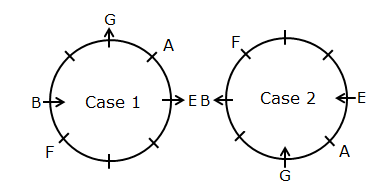
3) D faces away from the center and is second to the right of F.
4) H and C stand immediate left to each other.
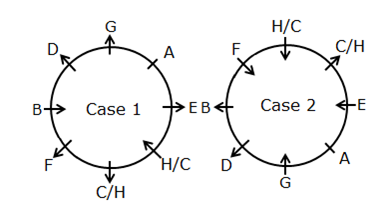
5) Both A and H doesn’t face towards the center. Hence, case 1 gets eliminated.
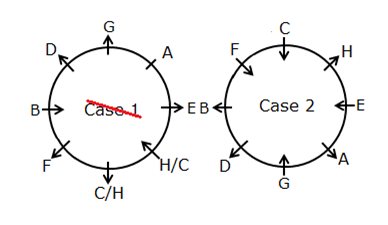
1) Answer: A
2) Answer: D
3) Answer: B
4) Answer: C
5) Answer: E
Directions (6-10) :

- S is sitting third to the left of W.
- X is sitting second to the right of W.
- X and W are facing the same direction and none of them are immediate neighbours of T.

- V is not facing the same direction as U and W.
- T is sitting third to the left of V.
- T and S are not an immediate neighbours.
- T is facing opposite to the centre and is a neighbour of R.
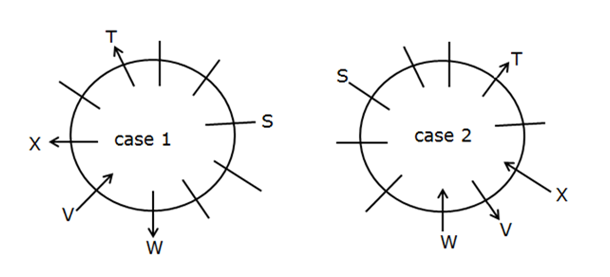
- The immediate neighbours of V are facing the same direction.
- The one who sitting opposite to R is facing opposite to the centre.
- T is an immediate neighbour of R.
- Q is sitting opposite to P and is facing toward the same direction.
- Q is sitting second to the left of Y. we cannot fix the position of R, P and Q in case 2 , so that case is eliminated.

- Both the immediate neighbours of U are facing opposite to the centre.
- S and R are not facing opposite to the center. So the final arrangement is ,
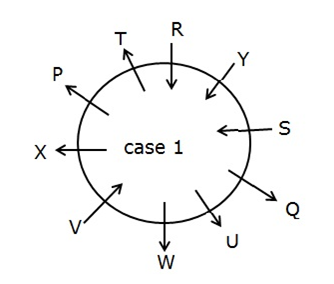
6) Answer: A
7) Answer: C
8) Answer: B
9) Answer: C
10) Answer: D
Download Circular seating Arrangement Questions for SBI/ IBPS PO Prelims Exam 2021 PDF
Try IBPS PO Free Online Mock Test
Try SBI PO Free Online Mock Test
Directions (11-15): Answer the questions based on the information given below.
Eight persons L, M, N, O, P, Q, R, and S are sitting at a circular table facing away from the centre. Each of them likes different banks viz. SBI, BOB, PNB, BOM, BOI, UBI, OBC, and CBI. All the information is not necessarily in the same order.
The one who likes PNB sits second to the left of the one who sits opposite to the one who likes CBI, who sits immediate right of L. One person sits between L and S.P sits third to the left of O, who likes SBI. P likes neither CBI nor PNB. O is not sitting adjacent to the one who likes CBI.Q sits immediate left of N, who likes UBI. R sits second to the left of M. The one who likes BOB sits adjacent to the one who likes BOI, none of them sits adjacent to the one who likes SBI. S doesn’t like BOM. The one who likes BOB doesn’t sit adjacent to the one who likes OBC. The one who likes BOB or BOI doesn’t sit either adjacent or opposite to the one who likes UBI.
11) Which of the following statement/statements is/are true?
A.O sits third to the right of the one who likes UBI
B. The one who likes BOM sits second to the right of S
C. The one who likes BOB sits immediate left of the one who likes PNB
D. Both (b) and (c)
E. Both (a) and (b)
12) Which among the following doesn’t form a group?
A.M- BOB
B.R- UBI
C.S- BOI
D.Q- UBI
E.L- SBI
13) Who sits second to the left of the one who likes OBC?
A. The one who likes BOM
B.P
C. The one who likes BOB
D. Both (b) and (c)
E. Both (a) and (b)
14) What is the position of Q with respect to the one who likes SBI?
A. Immediate right
B. Third to the left
C. Second to the right
D. Third to the right
E. Immediate left
15) Who sits third to the left of M?
A. The one who likes UBI
B. The one who likes BOM
C. The one who likes CBI
D. The one who likes PNB
E. None of these
Direction (16-20): Answer the questions based on the information given below.
Eight persons P, Q, R, S, T, U, V, and W are sitting around a circular table facing away from the centre but not necessarily in the same order. All the persons are sitting at an equal distance between them.
Q sits third to the left of the one who sits opposite to S, who sits second to the right of P. Two persons sit between V and R. U sits second to the left of R. P doesn’t sit adjacent to U. The number of persons sits between W and S is same as the number of persons sits between S and T, who doesn’t sit immediate left of R.
16) How many persons sit between T and V when counted from the left of T?
A. None
B.1
C.6
D.5
E. None of these
17) Which of the following statement/statements is/are not true?
A.Two persons sit between S and W when counted from the right of S.
B.Q sits third to the left of R
C.T sits immediate right of P
D.Both (a) and (b)
E.Both (b) and (c)
18) Who sits third to the right of W?
A.The one who sits opposite to U.
B.Q
C.The one who sits immediate right of V
D.V
E.None of these
19) Who among the following sits opposite to Q?
A.The one who sits to the immediate left of P
B.S
C.R
D.T
E.Both(a) and (d)
20) What is the position of U with respect to T?
A. Fifth to the left
B. Third to the right
C. Third to the left
D. Fourth to the right
E. None of these
Try Seating Arrangement Questions Online Mock Test
Answers :
Directions (11-15) :
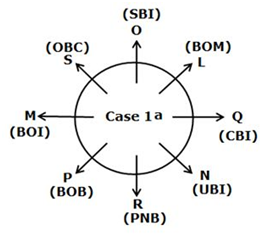
- The one who likes PNB sits second to the left of the one who sits opposite to the one who likes CBI, who sits immediate right of L.
- One person sits between L and S.
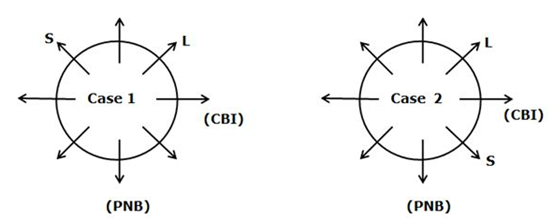
- P sits third to the left of O, who likes SBI.
- P likes neither CBI nor PNB. O is not sitting adjacent to the one who likes CBI
- Q sits immediate left of N, who likes UBI.
- R sits second to the left of M.
- The one who likes BOB sits adjacent to the one who likes BOI, none of them sits adjacent to the one who likes SBI.
- S doesn’t like BOM.
- The one who likes BOB doesn’t sit adjacent to the one who likes OBC.
- The one who likes BOB or BOI doesn’t sit either adjacent or opposite to the one who likes UBI.
- So the final arrangement becomes:

11) Answer: B
12) Answer: D
13) Answer: D
14) Answer: C
15) Answer: A
Directions (16-20) :
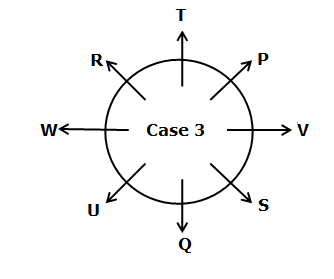
- Q sits third to the left of the one who sits opposite to S, who sits second to the right of P.
- Two persons sit between V and R.

- U sits second to the left of R.
- P doesn’t sit adjacent to U.
- The number of persons sits between W and S is same as the number of persons sits between S and T, who doesn’t sit immediate left of R.
- So the final arrangement becomes:

16) Answer: D
17) Answer: C
18) Answer: A
19) Answer: E
20) Answer: C





